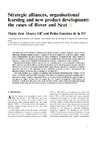Please use this identifier to cite or link to this item:
https://accedacris.ulpgc.es/handle/10553/76867
| DC Field | Value | Language |
|---|---|---|
| dc.contributor.author | Álvarez Gil, María José | en_US |
| dc.contributor.author | González de La Fe, Pedro | en_US |
| dc.date.accessioned | 2020-12-20T20:06:57Z | - |
| dc.date.available | 2020-12-20T20:06:57Z | - |
| dc.date.issued | 1999 | en_US |
| dc.identifier.issn | 0033-6807 | en_US |
| dc.identifier.other | Scopus | - |
| dc.identifier.other | WoS | - |
| dc.identifier.uri | https://accedacris.ulpgc.es/handle/10553/76867 | - |
| dc.description.abstract | The importance of the automotive industry in the global economy is widely recognised. The sector has undergone enormous changes in order to prepare for the fierce competition of the 21st century. Among these transformations, the most relevant are those technologies developed for the rapid evolution of activities linked to new designs, new products, and new manufacturing processes and systems. Innovative Japanese carmakers have stimulated international performance comparisons in these activities. International technology alliances may be one way of gaining access to new competitive technologies. Risks and costs associated with new product development can be shared among the partners and more effective use can be made of manufacturing facilities and production capabilities. Sometimes, an alliance agreement may lead to the deployment of new capabilities. However, in spite of this potential, the literature presents the success rate of alliances at less than 50%. Our study considers two examples of companies that developed international joint ventures (IJVs): Rover with Honda, and Seat with Volkswagen. Since these two European peripheral companies, Rover and Seat, no longer remain as independent firms, we are interested in identifying the reasons leading to the success or failure of these IJVs as regards the New Product Development (NPD) process. In particular, in both cases the paper looks at the problems of the weaker partner becoming increasingly dependent on the other partner and the need for a well-defined strategy to benefit from IJVs. | en_US |
| dc.language | eng | en_US |
| dc.relation.ispartof | R and D Management | en_US |
| dc.source | R and D Management [ISSN 0033-6807], v. 29 (4), p. 391-404, (Octubre 1999) | en_US |
| dc.subject | 3317 Tecnología de vehículos de motor | en_US |
| dc.subject.other | International Joint Ventures | en_US |
| dc.subject.other | Knowledge | en_US |
| dc.title | Strategic alliances, organisational learning and new product development: the cases of Rover and Seat | en_US |
| dc.type | info:eu-repo/semantics/Article | en_US |
| dc.type | Article | en_US |
| dc.identifier.doi | 10.1111/1467-9310.00149 | en_US |
| dc.identifier.scopus | 0033441253 | - |
| dc.identifier.isi | 000083119400008 | - |
| dc.contributor.authorscopusid | 7801528529 | - |
| dc.contributor.authorscopusid | 6506817543 | - |
| dc.description.lastpage | 426 | en_US |
| dc.identifier.issue | 4 | - |
| dc.description.firstpage | 423 | en_US |
| dc.relation.volume | 29 | en_US |
| dc.investigacion | Ingeniería y Arquitectura | en_US |
| dc.type2 | Artículo | en_US |
| dc.contributor.daisngid | 541435 | - |
| dc.contributor.daisngid | 19320937 | - |
| dc.description.numberofpages | 14 | en_US |
| dc.utils.revision | Sí | en_US |
| dc.contributor.wosstandard | WOS:Gil, MJL | - |
| dc.contributor.wosstandard | WOS:de la Fe, PG | - |
| dc.date.coverdate | Octubre 1999 | en_US |
| dc.identifier.ulpgc | Sí | en_US |
| dc.description.jcr | 0,519 | |
| dc.description.jcrq | Q2 | |
| dc.description.ssci | SSCI | |
| item.fulltext | Con texto completo | - |
| item.grantfulltext | open | - |
| crisitem.author.fullName | Gonzalez De La Fe,Pedro | - |
| Appears in Collections: | Artículos | |
SCOPUSTM
Citations
15
checked on Jun 8, 2025
WEB OF SCIENCETM
Citations
9
checked on Feb 25, 2024
Page view(s)
186
checked on Dec 30, 2023
Download(s)
181
checked on Dec 30, 2023
Google ScholarTM
Check
Altmetric
Share
Export metadata
Items in accedaCRIS are protected by copyright, with all rights reserved, unless otherwise indicated.
